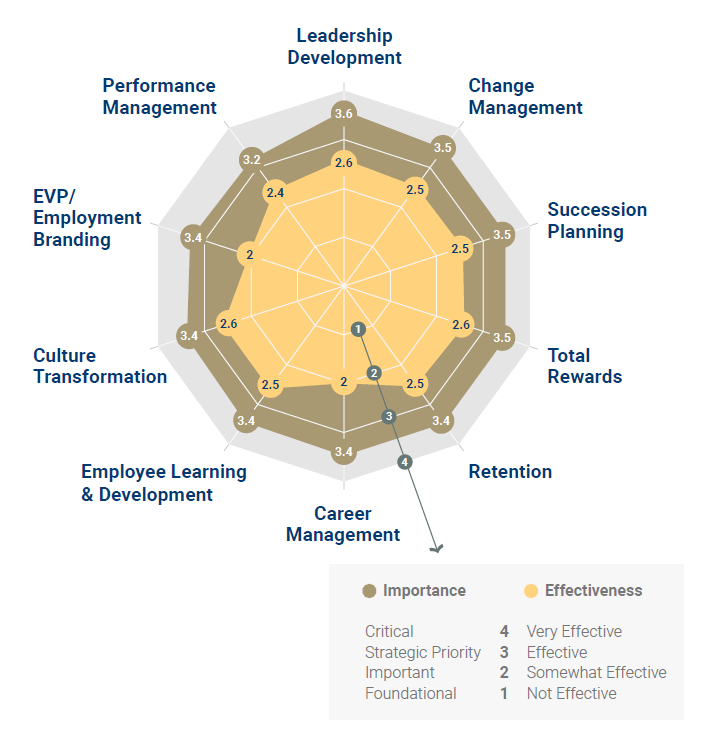share on
Make culture your competitive edge, transform the talent you have into the talent you need, and integrate DEI across all facets. Read on to find out more.
Organisations must act now to ensure closer alignment between business and talent strategies, and clearly articulate the capabilities, skills, and mindsets required to accelerate their talent for tomorrow, as highlighted in Kincentric’s latest report Accelerating Talent for Tomorrow: Five Game Changers to Drive Business Impact.
Having gathered insights from chief human resource officers (CHROs) and talent heads globally across 15 industries, the report has outlined the top talent issues businesses and leaders should take note of when taking new approaches to their talent strategies.
Here are some key takeaways from the report.
Top talent priorities
Talent priorities are generally consistent across all regions, with recruitment, attraction, and developing a talent pipeline regularly ranked as among the top three.
Diversity, equity, and inclusion (DE&I) is also a key focus across all regions, while retention and employee engagement are considered high-priority in North America and Asia-Pacific, but not in EMEA, where digital transformation is the key priority.
Top organisations are also focused on leadership development, equipping leaders with new skills and abilities to manage talent, activating succession planning, and transforming future-ready leaders.
Barriers to success
The report, however, revealed that even in leading organisations, there is much work to do to close the gap between the importance and effectiveness of various talent lifecycle components.
For example, knowing that talent attraction, development, and retention is a top talent priority, it is noteworthy that the biggest gaps between importance and effectiveness exist around employee value proposition (EVP)/employment branding and career development.
Importance and effectiveness of the 10 most important talent lifecycle elements

And the top five barriers that global talent leaders feel prevent them from achieving their talent priorities are:
- Inconsistent manager capability,
- Lack of business ownership of the talent agenda,
- Limited budget and funding,
- Limited capacity of the talent-related functions to effectively execute,
- Inadequate tools, resources, and HR technology.
To stay on top of the competition, the report outlined five game changers that will guide organisations as they shift their talent practices, models, and mindsets to future-proof themselves.
#1 Make culture your competitive edge for attracting and retaining talent
A bolder and more authentic EVP that’s rooted in your culture and values will act as a powerful tool for both attraction and retention. Conducting a culture assessment will help determine if you are driving the right employee experience.
#2 Transform the talent you have into the talent you need
Create an open and transparent internal talent marketplace that identifies existing employees for new roles and opportunities; ensure your career development philosophy and priorities are aligned; and focus on the development and upskilling of existing talent.
#3 Realise that future-ready talent will need future-ready leaders
Develop future-ready leaders equipped with new superpowers around resiliency, growth mindset, and openness to change. Support leaders at all levels with the incentives, tools, skills, self-confidence, and determination needed to become caring, engaging, and inclusive.
#4 Integrate DEI across all facets of talent and leadership
Prioritise efforts to create a fair, inclusive, equitable environment in which every employee has a voice, is valued, and can contribute their best. Recognise the difference between each of the three constructs of diversity, equity, and inclusion − and how each concept impacts talent and leadership at your organisation.
#5 Stay ahead of the curve with talent insights and analytics
Leverage talent analytics tools to help make informed people decisions, and prioritise investments and initiatives for maximum impact.
Finally, to implement impactful talent practices that contribute to business success, here're some questions HR leaders could ask themselves:
- Do you have a talent strategy that is directly aligned to your business strategy and key objectives?
- Does your talent strategy articulate your people philosophy and organisational capabilities required to achieve your business goals?
- Is there leadership commitment and understanding of the requisite behaviours to unlock your people and teams?
- Do you have the capabilities across the HR function and the broader organisation to design and deliver your talent programmes and priorities?
- Do you have a comprehensive change management strategy in place to successfully activate your own game changers?
Images / Shutterstock
share on


